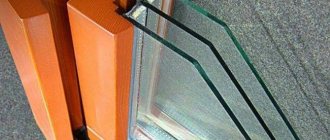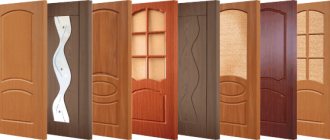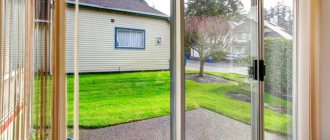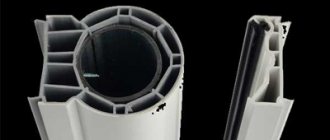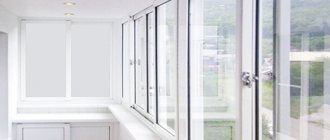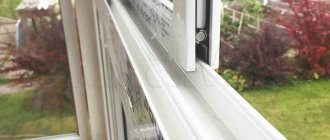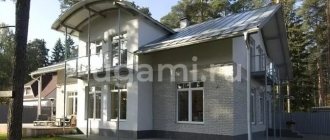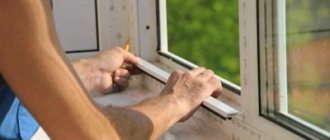A double-glazed window is a sealed glass structure of two or more glasses separated by spacer frames. Nowadays, single-chamber and two-chamber products are common, with glass of the same or different thicknesses, but along with them, the use of three-chamber analogues is gaining momentum.
What it is?
A three-chamber double-glazed window consists of four glasses (currently this is the maximum), which form three closed chambers filled with either inert gas or dried air. The distance between the glasses in each chamber, as well as the glasses themselves, can be different (asymmetrical layout) or the same (symmetrical layout).
Three-chamber double-glazed window with asymmetric chamber arrangement
Note! When they talk about plastic window structures about the presence of 4-7 cameras, they mean the number of cameras in the supporting profile, and not in the translucent elements.
Features of application
In domestic regions, three-chamber double-glazed windows are in little demand and are relatively rare. The reason for this is not the cost of additional glass or insulating gasket. The fact is that the vast majority of industries involved in the production of double-glazed windows are focused on one or two-chamber products. Making a three-chamber product using equipment not suitable for this is quite difficult and expensive. Because of this, production becomes piecemeal, which significantly affects the cost, which can be 50% higher than double-chamber analogues.
It makes sense to install three-chamber double-glazed windows in the following situations:
- The cold climate of the northern regions of the country, especially in the Arctic, where the loss of natural external light is not critical, since its level is already low;
- Glazing of buildings located near sources of increased noise and the need for its insulation;
A three-chamber double-glazed window has better noise insulation properties.
It is not recommended to install three-chamber double-glazed windows:
- In old buildings made of wood (for example, frame-type houses);
- As a translucent filling of large structures;
- For glazing loggias or balconies.
Disadvantages of triple glazing
Such glazing also has a number of disadvantages that preclude their installation in a number of individual cases. For example, the significant weight of such a structure. Three glasses with a thick profile are quite heavy, which is why such windows are not installed in old, dilapidated houses, as well as wooden houses without additional reinforcements. Not only because it is unsafe, but also because the walls may simply not withstand the applied load, even if they are load-bearing.
When glazing a large area, some difficulties also arise. In large areas - such as popular mirrored facades - heavy glass must be reinforced to improve safety and reliability.
For this purpose, jumpers, vents and other elements are installed. And the heavier the glass, the more such elements there must be, otherwise the glass may simply fall out. But such fortifications significantly worsen the appearance of the facade, complicate installation work, and therefore are considered a disadvantage.
Specifications
Three-chamber double-glazed windows and triple-glazed windows are often confused. Triple glazing implies the presence of three glasses in the design, which results in two separate chambers, that is, a double-glazed unit. To get a three-chamber one, you need four glasses and three spacer frames that form sealed chambers.
The external difference of three-chamber products is their greater thickness, in contrast to the translucent area, which in most cases is significantly smaller. This is due to the fact that each additional glass significantly increases the weight of the package, even when using standard 4 mm thick sheets. There are innovative developments with tempered glass 1.6 mm thick. The mass of such products is less than traditional two-chamber ones, but mass production is currently impossible due to the high cost.
Three-chamber profile or five-chamber That's what
Three-chamber profile or five-chamber? That is the question
Many buyers of new PVC windows, among other things, place high demands on their thermal characteristics, to which, as a rule, the most common answer is: “Take a five-chamber profile with three-chamber conventional or two-chamber energy-saving double-glazed windows.”
And if everything is simple with double-glazed windows, the more chambers, the better their thermal characteristics, then when we compare a three-chamber window profile and a five-chamber one, we will not see a noticeable difference in the thermal conductivity coefficient. What is the reason?
The pictures below show examples of a conventional three-chamber profile (left), a conventional five-chamber profile (center) and an energy-saving six-chamber profile (right). We marked the cut lines of the frame profile and the sash profile with blue lines, and the cut line in the plane of connection of the frame with the sash with red lines.
Three-chamber profile - the number of cameras along the blue lines is three, the number of cameras along the red line is three.
Five-chamber profile - the number of chambers in the section of the blue lines is five, the number of chambers in the section of the red line is the same three, this indicates that the plane of connection of the frame with the sash negates the advantage of five chambers and reduces the thermal conductivity coefficient to the level of a three-chamber profile.
Six-chamber profile - the number of chambers in the section of the blue lines is six, the number of chambers in the section of the red line is six, here we see a complex profile design that provides improved thermal characteristics in any plane.
Summary. The difference between a three-chamber and a five-chamber profile is in the rigidity of the structure, i.e. for most standard structures a three-chamber profile is sufficient; for large structures (glazing of balconies, verandas, etc.) it makes sense to use a five-chamber profile.
If you are interested in purchasing full-fledged energy-saving windows, then your choice is six-chamber or more profiles of a special design. The exception is blind windows made from a five-chamber profile, since in such windows there is only a main five-chamber frame, the thermal conductivity coefficient will be high.
Advantages and disadvantages
Positive qualities of three-chamber double-glazed windows:
- A significant increase in the thermal insulation characteristics of the window structure (up to 40% in comparison with two-chamber analogues);
- Good noise insulation performance in the high sound frequency range (low frequencies, such as noise from a passing train, are absorbed much less well);
- Low probability of condensation appearing on the internal elements of the double-glazed window.
Negative qualities:
- If the operating rules are not followed, partial destruction of the double-glazed window may occur due to exposure to stressful climatic loads;
- At the moment, there are no technologies for the manufacture of large three-chamber products;
- In comparison with high-quality two-chamber double-glazed windows, which have similar thermal insulation and noise-absorbing characteristics, three-chamber double-glazed windows are significantly more expensive (30%-50%);
- If energy-saving glass is installed inside a double-glazed unit, it may be partially destroyed as a result of thermal shock;
- High-quality three-chamber products are distinguished by their significant thickness (up to 60 mm), which requires the use of an appropriate profile system, the cost of which is noticeably higher than that for two-chamber or single-chamber products.
- The weight of a three-chamber double-glazed window, depending on the glass used, is almost a third more (up to 10 kg per square meter of area) in comparison with two-chamber analogues;
- Four glasses, some of which are covered with energy-saving film, absorb more than 12% of external sunlight, which makes three-chamber double-glazed windows quite dark.
Advantages of two-chamber systems
Window units with two chambers are the most popular glazing option. They can be used in any room and in any climate. The design reliably retains heat and does not let cold air flow into the room.
The characteristics of double-glazed windows indicate a number of advantages of such systems. Namely:
- Excellent sound insulation. The three-glass design reduces the noise level entering the room by up to 31 dB.
- High thermal insulation performance. A double layer of dry air or gas retains more heat than single-chamber counterparts. The heat transfer resistance coefficient varies from 0.40 to 0.72 m2 naoC/W.
- Environmental friendliness. Modern systems are manufactured using advanced technologies that allow the production of safe products.
Another advantage is the ease of use of plastic double-glazed windows. There is no need to paint them, seal the cracks or cover the glass with reflective film.
Selecting profiles and fittings
A common version of the symmetrical layout is 4 sheets of 4 mm each, located at a distance of 8 mm from each other.
Since this is a common size for double-glazed windows, there are no problems with selecting a frame profile, the only issue is that the profile structure is sufficiently strong to hold such a massive glazing. If you use thicker glass of different thicknesses and use an asymmetrical arrangement with 16 mm chambers, you can significantly increase the energy efficiency and soundproofness of a three-chamber double-glazed window. However, the final thickness of such a product will reach 64 mm, and in some cases exceed this value. Considering that three-chamber double-glazed windows are designed for installation in a profile, choosing one suitable for the above parameters is quite problematic, and in some cases impossible.
Note! At the moment, the only profile that has a sufficient installation size for a double-glazed window with a depth of 60 mm is Salamander BluEvolution, while the width of the profile itself in cross section is 92 mm.
Salamander Blu Evolution
To evenly distribute the load on the window structure, frames with three-chamber double-glazed windows are divided into small sections. This makes the window more rigid, however, sashes with such frames do not look harmonious on every building façade.
Which double glazing unit should I install 2 or 3 glasses?
Definitely, a double-glazed window with three glasses (or correctly called a two-chamber double-glazed window) is warmer than a single-chamber with two glasses.
In addition to the fact that a double-chamber double-glazed window is 30-40% warmer than a single-chamber one, it has better sound insulation and better resistance to fogging, since the inner glass is separated from the cold street zone by an additional chamber.
There are only two minor disadvantages to double-glazed windows:
- Weight. The structure of the window in this case is heavier (but good fittings are designed to hold such double-glazed windows with a large margin, and there is no need to be afraid to install them in all cases).
- Price. Double-glazed windows are more expensive. But is it worth saving about 500 rubles on one window to get an almost twice as cold window?
An ordinary single-chamber double-glazed window is designed for operation up to temperatures of about -20 degrees, while a double-chamber double-glazed window is designed to operate at temperatures of -35 and below.
Therefore, if you want to have comfortable conditions at home all winter, choose double-glazed windows. At the same time, we recommend that you choose double-glazed windows with energy-saving glass (the increase in price will be insignificant).
We often hear from our customers that the neighbors installed single-chamber double-glazed windows and the windows do not sweat. Be careful with this opinion.
- Firstly: neighbors cannot always tell the truth - who wants to admit that they made a mistake with their choice.
- Secondly, the absence of fogging of windows is only an indirect sign by which you can evaluate the climate in the room, the quality of installation, but you cannot estimate how much the windows retain heat in the room (especially if you heat it from your pocket).
- Thirdly, the cost of single- and double-glazed windows differs only by 500 rubles per window - you must agree - this is not the money for which you can deny yourself the comfort and confidence of your windows.
For more information about what other double-glazed windows there are (for example, sun-protection windows), see the article “Energy-saving windows: regular price”, as well as a brief description of what a “double-glazed window” is.
We are also often asked how to determine how many glasses are in an already installed double-glazed window? The fact is that due to optical refraction, the middle glass is not visible.
The answer is very simple - just hold a lighter and count the number of reflections - there will be 6 of them if the double-glazed window is three glasses, since each glass surface reflects.
Approximate cost of three-chamber double-glazed windows and windows using them
The price of three-chamber double-glazed windows directly depends on the layout of the chambers (symmetrical, asymmetrical), their filling (dried air, inert gas), thickness and energy-saving characteristics of the glass. The most budget option with the same glass 4 mm thick and 8 mm cameras will cost about 6,000 rubles per square meter , while few organizations will undertake the manufacture of products with a total area of less than 1 m2.
Energy-saving symmetrical structures, with four-millimeter glass (external with a special coating), will cost from 7,000 per m2 . If additional sound insulation is needed, the outer glass is made thicker and the depth of the chambers is different (asymmetrical layout). The price of such double-glazed windows starts from 8,500 rubles per m2 .
Cost of windows with three-chamber double-glazed windows
In addition to the glass unit, the cost of a window is influenced by many factors. First of all, this is the profile used for manufacturing, namely: its cross-sectional dimensions, the number of chambers, the thickness of the outer wall and internal partitions, the presence of a thermal insulation insert and a reinforcing element. Also important are the technical conditions of installation, the installation of the window with a window sill and a drip profile.
A high-quality window structure (1440 x 1160 mm), made from the VEKA SOFTLINE profile for a 52 mm double-glazed window, with energy-saving translucent filling will cost at least 15,000 rubles .
Advantages of energy-saving double-glazed windows
The use of energy-saving double-glazed windows is becoming more popular. In such a package, one glass is covered with a thin I-coating, which transmits light and thermal radiation from the sun and reflects thermal energy from heating devices back into the room.
Energy-saving I-glass is produced using a “soft” method and is coated with a thin layer of silver, almost invisible to the human eye. It is called a thermal mirror and is placed inside a double-glazed window to preserve the coating from dust and moisture. This allows you to keep the house warm in the winter and cool in the summer.
Filling the air chamber of an energy-saving double-glazed window with inert gas increases the thermal insulation capacity by 11%. Argon has higher viscosity and lower thermal conductivity than air. Thus, with the slow movement of argon particles, there is less heat transfer between the inner and outer glass.
In addition to saving energy for additional heating of the room, energy-saving double-glazed windows protect wallpaper, furniture and carpets from fading. It maintains a comfortable microclimate near the window. The glass always remains warm, this eliminates the formation of condensation and freezing, and creates much better sound insulation.
A single-chamber double-glazed window with energy-saving heat is lighter in weight than a regular double-chamber one.
The service life of an energy-saving window is 10-15 years. During this time, the argon gradually evaporates, but it remains much warmer than usual and, on the other hand, the double-glazed window simply turns into an ordinary one.
The most effective heat saving coefficient is considered to be double-glazed windows with inert gas and two energy-saving glasses. In addition, windows of this design can greatly increase noise insulation and protect against ultraviolet radiation.
When choosing a plastic window, it is important to consider that this design is ideally purchased for decades. Saving on small things can result in great disappointment, and possibly additional expenses later.
Where is it better to install single-chamber double-glazed windows?
Often, problems with heat loss and high noise levels in the room are associated with the wrong choice of double-glazed windows. The desire to save a couple of thousand rubles on a cheaper option can play a cruel joke: you will have to overpay for the reinstallation of almost new windows.
In addition, in many large cities, state commissions prohibit the installation of single-chamber double-glazed windows, since, according to SNiP, the thermal characteristics of such windows are not suitable for the middle zone and, especially, for the northern regions. In what cases will the installation of a single-chamber double-glazed window be justified?
Glazing of balconies and loggias
If you do not plan to insulate this room and make it a residential part of the apartment, it is not advisable to overpay for heat-resistant double-glazed windows. In addition, the lightweight design of such windows will not harm the hanging balcony at all;
Installation of a balcony block
If your balcony is glazed, even with ordinary wooden frames, you will no longer need to install an interbalcony door and double-glazed window. The balcony space will serve as a second chamber, so that the room temperature will remain the same;
Glazing of a summer house
Glazing of a terrace in a house
The reasons why it is better to install single-chamber plastic windows on the terrace are the same as in the case of glazing a summer house.
Window installation in the southern regions
It makes no sense to overpay for unnecessary advantages and additional characteristics if the average temperature in your region during the cold season does not fall below -10 degrees Celsius.
What is good about a five-chamber profile of a plastic PVC double-glazed window?
What is good about a five-chamber profile of a plastic (PVC) window (double glazing)?
Plastic windows, regardless of how much glass they contain, may well be considered the standard for modern living conditions. But the quality of these conditions determines the variety of PVC designs, which is already quite large. Just look at the differences in appearance, which in the case of plastic structures is almost of primary importance for many buyers.
Unique shapes, toning, colors. All this delights both the owners of the premises and ordinary passers-by. Of course, appearance is not the main parameter of a plastic window. After all, if a window unit looks beautiful, but does not protect you from the cold, then it is worthless
This is not always the case, as I am about to convince you of.
Five-chamber double-glazed window: main advantages
Let's start with the good. Five cameras is, perhaps, the maximum possible number available to customers of modern designs. Since there are five cameras, there will be six glasses. The profile width for this double-glazed window will be 70 millimeters. For comparison, the three-chamber profile has a width of 60 millimeters, which is not much smaller. In return, you get improved thermal insulation, sound insulation and reliability. You are guaranteed to maintain comfort and warmth in the apartment, which is ensured by an increase in thermal insulation performance by 30 percent. The large width will reliably protect the frame from freezing even at low temperatures outside the window, and condensation will never form on the glass. Also, do not forget about sound insulation, which will be maximum.
Five-chamber plastic window: main characteristics
#8212 Six glasses.
#8212 Mounting profile 70 millimeters wide (can be extended to 120 millimeters).
#8212 Outer wall 3 millimeters wide.
#8212 Heat transfer coefficient #8212 0.15 W/m2C°.
Where are these windows installed?
In principle, a five-chamber profile can be installed in any region, even if the difference in seasonal temperatures is insignificant. It will exhibit its main advantages in any case. You can glaze your apartment, or use the structure to glaze a loggia, balcony or office. In all these cases, the person will be reliably protected from severe weather troubles or from extraneous sounds.
Where to buy a five-chamber window?
Judging by the reviews, almost every manufacturer produces five-chamber designs, but I will tell you about those that are considered the most optimal, high-quality and durable.
#8212 Rehau Brilliant-design - a five-chamber system with a glass unit width of 41 millimeters and a profile width of 70-78 millimeters.
#8212 VEKA SOFTLINE - a five-chamber system with a 70 mm mounting profile and a double-glazed window 6-42 mm wide.
#8212 KBE Expert - a system with five cameras, a 70 mm profile, 42-58 mm double-glazed windows and sound insulation at 42 dB.
#8212 Montblanc City 120 - a profile with a width of 120 millimeters, with a heat transfer coefficient of 0.72 W/m2C° and durability of up to sixty years.
#8212 Montblanc Nord 70 – 70mm wide five-chamber profile, guaranteeing first class thermal protection. The glass unit has a width of 42 millimeters. Heat transfer coefficient (subject to the use of a steel liner) #8212 0.77 W/m2C°.
#8212 Plafen S-line – 75 mm profile with an additional insulating contour, which suggests the presence of an additional sixth chamber.
#8212 EXPROF Suprema - a system with a three-circuit seal, a 70 mm profile and a 46 mm glass unit.
#8212 THYSSEN - five cameras, 71 mm profile, 47 mm double-glazed window. Able to cope with temperatures from 60 degrees below zero to 75 degrees above zero.
#8212 LG Chem 700 – 70mm profile with 3mm outer wall thickness and 13-42mm glass unit.
#8212 TROCAL Balance 70 – five-chamber design with a 70 mm plastic profile and a 40 mm double-glazed window. Durability up to half a century.
Which material to choose
When choosing windows, the buyer often wonders which double-glazed windows are better - aluminum or plastic. The choice depends on what you want to achieve from your windows. Aluminum is a material that is not capable of retaining heat, so it is most often used for unheated balconies and rooms. There are lightweight aluminum windows with thermal bridges; they are warm, but much more expensive than their plastic counterpart. PVC windows are always warm, since plastic is a serious barrier to air (it does not allow air to pass through at all), but not all structures, especially balcony ones, can withstand its heavy weight.
The plastic option will be cheaper if you need an insulated room; for an unheated room, an aluminum profile is often used.
One or two cameras
When choosing windows for their home, buyers often wonder what is better - single-chamber or double-glazed windows? To answer this question, you need to study what differences the products have and for what operating conditions they are intended.
A single-chamber double-glazed window is quite thin and freezes at temperatures above -15 degrees. In addition, it cannot provide sufficient retention of warm air in a room that becomes cold due to serious heat loss. It is most often used for non-residential premises and balconies. The two-chamber design copes better with retaining heat in the room, is used for heated houses, and insulates noise well.
The main difference between single-chamber and double-chamber double-glazed windows is that the double-chamber design is more frost-resistant, it copes better with different climatic conditions, retains heat and noise. The profile is usually insulated, which is often absent in single-chamber double-glazed windows, since this is the most budget option that developers can use or if the amount of funds for building a house is strictly limited, but some windows need to be inserted.
That is why owners of a single-chamber design often want to replace it with a two-chamber one. However, is it possible to change a single-chamber double-glazed window to a double-chamber one without completely changing the window? Technically, this procedure can be performed. It depends entirely on the width and functionality of the profile; some allow you to place a thicker glass unit in them. If you are lucky and the profile is just like this, then you just need to pull out the single-chamber structure and insert a two-chamber one instead. In order to determine whether this can be done, you need to consider the following:
- Profile thickness. The greater the installation depth, the greater the likelihood that a two-chamber design is suitable for such a profile. You can find out the exact numbers from the technical characteristics of the profile; in extreme cases, you can remove the glass unit and measure the width.
- The strength of the profile will also need to be taken into account: a thicker double-glazed window weighs more, and therefore will place an increased load on the sash. It may warp if the profile is not reinforced enough.
- You may have to replace the fittings with something more durable and of higher quality.
Another important difference between a single-chamber double-glazed window and a double-chamber one is the thickness of the air chambers themselves. If it is small, then the buffer between the street and the room will not give a good result.
Two thick chambers retain heat well, especially if they are not just sealed, but filled with argon. If a double-glazed window is depressurized, it will be no more useful than conventional cold glazing.
You can replace a single-chamber double-glazed window with a double-chamber element if you use a design with sufficiently thin glass, however, as practice shows, such a replacement will be little noticeable, unless it makes you feel more morally comfortable. The heat will increase a little, so if the thickness of a single-chamber double-glazed window was 24 mm, and a double-chamber one becomes 27, you will only waste time and money. The resistance coefficient will change from 0.32 to 0.42, which in practice will hardly add several degrees of heat to the room.
There is another solution to the problem - using energy-saving double-glazed windows. To do this, you need to compare which is better - a double-chamber double-glazed window or a single-chamber energy-saving one. Energy-saving windows are covered with the thinnest metal film. It significantly improves the physical properties of a double-glazed window, since the membrane repels warm air, forcing it to remain indoors, and does not let cold air in from the outside.
If you compare a thin double-glazed window with a standard thickness single product, but using this technology, there will be a noticeable difference in favor of the second one, since the room will be several degrees warmer. Therefore, in many cases it is more profitable to use energy-saving double-glazed windows than to try to install thicker ones. Their advantage is that you can install a double-glazed window of the same width as it was and you won’t have to change the entire window, but the desired effect will be achieved.
How our team works
The cost of the service provided includes:
| Measurement The visit of a measurer is always required. Any errors in measurements by a non-professional can lead to problems in the installation and subsequent operation of the doors. Only a specialist is able to competently assess the structural features of doorways in different types of houses. We have a surveyor visit BEFORE signing the contract! |
| Consultation with a design engineer Professional recommendations, selection of the optimal type of profiles and fittings, accurate calculations when visiting the client’s address and drawing up a contract. |
| Production from 7 days Standard entrance, interior and balcony doors from the selected type of profile will be ready for installation within 7-8 working days. Profile lamination, glass tinting and other services affect production time. |
| Delivery We agree in advance with the Customer on a convenient day and time for delivery. Transportation is carried out by specially equipped vehicles. |
| Installation Our specialists, if necessary, will dismantle old door frames. The installation of plastic doors is guaranteed, as is the door system itself. |
| Garbage removal We are used to leaving things in order after ourselves. If the client wishes, we remove construction waste and old doors ourselves. |
